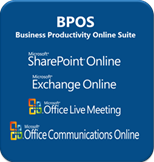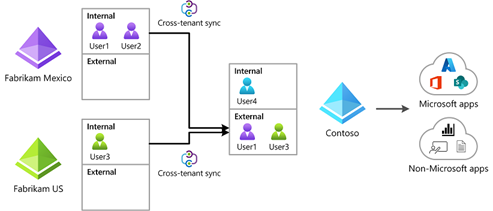Microsoft 365 serves as a vital, modern, and secure cloud platform globally, supporting businesses and organizations in document creation, communication, collaboration, and process automation. Reflecting on the past, it's remarkable to see the evolution of productivity tools and the limited features that were available online when Microsoft launched BPOS (Business Productivity Online Suite) in 2008, which was the forerunner of Microsoft 365.
Core workloads offered in BPOS in 2008:

Here at Spyglass, we’ve been fortunate to help our customers through the journey from Microsoft BPOS through to Office 365 and now to Microsoft 365 for the last 15 years. As we’ve seen organizations grow, merge, or restructure, one of the key decisions they face and seek our input on is whether to migrate content from one tenant to another or to connect multiple Office 365 tenants to each other.
Until early 2023, cross tenant collaboration and data sharing was limited to configuring external sharing settings and enabling guest access. With the introduction of Microsoft Cross-Tenant Synchronization (aka Multitenant Collaboration – see here https://learn.microsoft.com/en-us/microsoft-365/enterprise/plan-multi-tenant-org-overview) organizations now have a much more streamlined and robust way to configure and manage integrations that make searching for users, using Microsoft Teams and meetings, and collaborating on files more seamless across an organization’s multiple tenants.
While having the option to seamlessly connect multiple tenants together for users might seem like a silver bullet, it doesn’t mean that it is the best approach for all circumstances. In this blog post, we will briefly explore the Cross-Tenant Synchronization vs. Migration Tools options and help you make an informed decision on which path is right for your specific situation.
Cross-Tenant Syncing: Bridging the Gap
Cross-Tenant Syncing is a method that allows organizations to maintain connections to multiple Office 365 tenants, each with their own settings, configurations, and users. It synchronizes data, such as user accounts, groups, and certain types of content, between these tenants. Here's how it can help you:
- Maintain Autonomy: If your organization needs to keep different teams, subsidiaries, or regions separated due to geographic, regulatory, or licensing differences, while still enabling some level of collaboration and synchronization, Cross-Tenant Syncing can be a viable solution.
- Gradual Transition: You can use this method when you want to slowly merge tenants or when there is a need to maintain separate environments for an extended period.
- Content Sharing: Cross-Tenant Syncing can facilitate the sharing of resources while keeping core configurations and data security and tenant configuration policies separate.
- Enhanced Security: Organizations can ensure consistency by accepting and controlling MFA policies and device compliance across multiple tenants.
While the setup of a Microsoft 365 multitenant organization takes place in the Microsoft 365 Admin Center, much of the supporting infrastructure is in Microsoft Entra ID (formerly known as Azure Active Directory). Multitenant organizations synchronize users between tenants using Microsoft Entra ID B2B collaboration users.
Cross-tenant synchronization automates creating, updating, and deleting B2B collaboration users. Users created with cross-tenant synchronization are able to access both Microsoft applications (such as Teams and SharePoint) and non-Microsoft applications (such as ServiceNow and Workday), regardless of which tenant the apps are integrated with.
Users from one tenant are provisioned in the other tenants in the multitenant organization as B2B collaboration users (External Users) but with a user type of member rather than guest. The ability to designate a synchronized user as a member and not just a guest is a key aspect of ensuring that the Teams collaboration integration is not limited to just the capabilities that guest access provides.
The diagram provided by Microsoft below highlights how multiple tenants, possibly across multiple countries, can be synchronized to allow for access to common applications and functionality while at the same time maintaining tenant governance and regional separation.

Migration Tools: Moving with Purpose
Migration tools are designed for those situations when simply synchronizing users and groups between tenants is not enough and there is therefore an important need to physically copy / move data and content from one Microsoft 365 tenant to another. This method is best suited for organizations looking to consolidate or migrate to a single tenant.
Here are some reasons why organizations typically choose to utilize a Migration Tool as opposed to staying with the status quo of managing and maintaining multiple tenants or implementing Cross-Tenant Syncing:
- Consolidating Resources: One of the primary reasons to migrate data and content is to consolidate resources. It allows the organization to operate from a single Office 365 tenant, streamlining administrative tasks including security and monitoring, reducing overhead costs, and achieving operational efficiency. This consolidation simplifies user management, licenses, and overall IT management.
- Data Cleanup and Organization: Tenant migrations provide an opportunity to clean up and organize data. Redundant, obsolete, or trivial data can be identified and removed during the process, resulting in a more efficient and organized content repository.
- Common and Consistent Compliance and Regulatory Policies: Organizations may have a standard set of compliance and regulatory policies that need to be adhered to by all subsidiaries and teams. Migrating data to a single tenant allows companies to consolidate and maintain their policies and compliance standards in a single tenant, ensuring a consistent approach.
- Optimizing Licenses and Costs: Microsoft 365 licenses come at a cost, and the move to a common tenant presents an opportunity to optimize these expenses. Migrating users and data can include a review of licenses, 3rd party tool usage, and a plan to scale down or scale up according to the centralized needs, potentially reducing unnecessary expenditures.
- Enhancing Collaboration Through Standardization: Migrating data between tenants promotes easier and enhanced collaboration. It ensures that all employees can seamlessly access and collaborate on documents and files using a single, common approach without having to navigate through multiple tenants or to have to choose a specific tenant or organization when browsing for users or collaboration sites. This improved collaboration can lead to increased productivity and innovation within the new organization.
- Retaining Historical or Compliance Data in a Single Place: Historical data holds significant value, whether for compliance, auditing, or decision-making purposes. Migrating data to a single tenant ensures that valuable historical records, emails, and documents are retained, which is often a legal requirement in various industries.
For an overview of the Spyglass team’s Microsoft 365 migration capabilities and approach see here: https://www.spyglassmtg.com/microsoft-365-services/migrations
Making the Decision
The choice between Microsoft 365 Cross-Tenant Syncing and Migration Tools is not a one-size-fits-all decision. It depends on your organization's unique circumstances, goals, and data requirements. By carefully evaluating your needs and considering the factors highlighted in this blog post, you can make an informed decision that will best serve your organization's future growth and collaboration needs. Here is a summary of the key factors to consider:
- Scope of the Project: Determine the extent of the changes you need to make. Cross-Tenant Syncing is best when there are high priority internal or external factors that are driving the need for an organization to maintain separate tenants. Migration Tools are ideal for full-scale consolidation to a tenant that provides a single point of integration and management along with the benefits that provides.
- Long-Term vs. Short-Term: Evaluate your organization's long-term strategy. Cross-Tenant Syncing is suitable for maintaining autonomy, especially if there is a potential that an entity may be sold or spun off in the near future. Migration tools are better for long-term consolidation.
- Data Types: Consider the type and quality of data you need to move or sync. There are certain categories of content and functionality (e.g., Bookings, Microsoft Forms, Power Apps, Power Automate, Power BI) that cannot be migrated using a tool and must be manually moved or recreated. If this is a large concern, then keeping the data in the existing tenants and focusing on tenant synching makes sense. If you want to use the migration process to leave behind unnecessary data, or to reorganize or restructure content and sites, then migration tools are the better choice.
- Project Costs and Ongoing Costs: Cross-Tenant Syncing provides a path to quick user collaboration improvements across tenants with minimal time and effort. Leveraging a migration tool and migrating all relevant content to a single tenant will cost more initially but should eventually pay for itself via a reduction in management, compliance, licensing, and end user training expenses.
- Consult with Experts: When in doubt, Spyglass resources would be happy to step in to review your specific needs, to walk you through the various options to consider, and to provide tailored advice. Contact us today!
